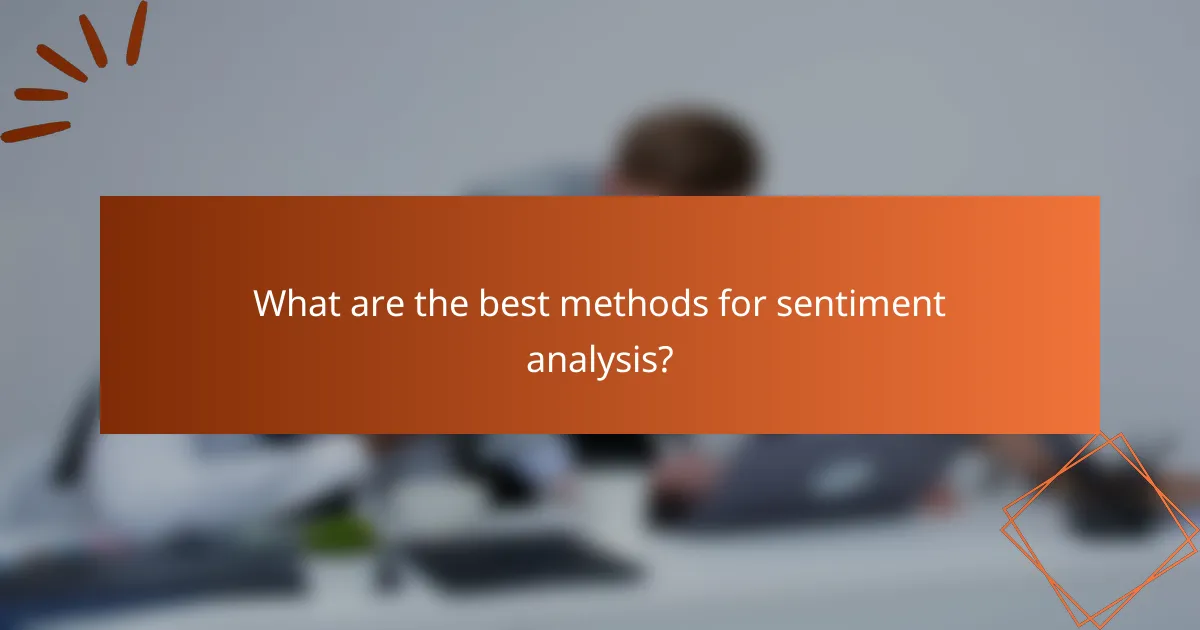Sentiment analysis is a powerful technique that utilizes various methods such as Natural Language Processing (NLP) and machine learning to interpret emotional tones in text data. By employing effective tools tailored to specific needs, brands can gain valuable insights into customer opinions and emotions, ultimately enhancing customer satisfaction and informing strategic decisions. Understanding the strengths and weaknesses of different sentiment analysis approaches is crucial for optimizing their application in real-world scenarios.

What are the best methods for sentiment analysis?
The best methods for sentiment analysis include Natural Language Processing (NLP), machine learning algorithms, lexicon-based approaches, deep learning techniques, and hybrid models. Each method has its strengths and weaknesses, making them suitable for different types of sentiment analysis tasks.
Natural Language Processing (NLP)
NLP is a foundational method for sentiment analysis that focuses on the interaction between computers and human language. It involves techniques such as tokenization, part-of-speech tagging, and named entity recognition to extract meaning from text. By understanding the structure and context of language, NLP can effectively determine sentiment polarity.
Common tools for NLP include libraries like NLTK and spaCy, which provide pre-built functions for processing text. When using NLP, ensure to clean and preprocess your data to improve accuracy, as unstructured text can lead to misinterpretations.
Machine Learning Algorithms
Machine learning algorithms utilize statistical methods to classify sentiment based on training data. Popular algorithms include Support Vector Machines (SVM), Naive Bayes, and Random Forests, which can learn from labeled datasets to predict sentiment in new texts. These models often require a significant amount of data for training to achieve reliable results.
When implementing machine learning for sentiment analysis, consider feature extraction techniques like TF-IDF or word embeddings to enhance model performance. Regularly evaluate your model’s accuracy to avoid overfitting and ensure it generalizes well to unseen data.
Lexicon-Based Approaches
Lexicon-based approaches rely on predefined lists of words associated with positive or negative sentiments. By analyzing the frequency and context of these words in a text, these methods can assign a sentiment score. This approach is straightforward and interpretable, making it easy to understand how sentiment is derived.
However, lexicon-based methods may struggle with sarcasm or context-dependent phrases. To improve accuracy, consider using domain-specific lexicons that reflect the language and sentiment nuances of your target audience.
Deep Learning Techniques
Deep learning techniques, such as recurrent neural networks (RNNs) and convolutional neural networks (CNNs), have gained popularity for sentiment analysis due to their ability to capture complex patterns in data. These models can automatically learn features from raw text, often outperforming traditional methods when trained on large datasets.
While deep learning can yield high accuracy, it requires substantial computational resources and data. Ensure you have access to sufficient labeled data and consider using transfer learning with pre-trained models to reduce training time and improve results.
Hybrid Models
Hybrid models combine multiple sentiment analysis methods to leverage their strengths and mitigate weaknesses. For example, a hybrid approach might integrate machine learning with lexicon-based methods to enhance accuracy and interpretability. This can be particularly effective in capturing nuanced sentiments in complex texts.
When developing hybrid models, experiment with different combinations of techniques to find the best fit for your specific use case. Regularly validate your model against real-world data to ensure it meets performance expectations and adapts to changing language trends.

Which tools are most effective for sentiment analysis?
Effective sentiment analysis tools leverage natural language processing to interpret emotional tone in text data. The best tools vary in features, ease of use, and integration capabilities, making it essential to choose one that aligns with your specific needs.
IBM Watson Natural Language Understanding
IBM Watson Natural Language Understanding offers advanced sentiment analysis capabilities, allowing users to analyze text for emotional tone, categories, and keywords. It utilizes machine learning algorithms to provide insights into customer opinions and brand perception.
Consider its integration with other IBM services for a comprehensive data analysis solution. Pricing is typically based on usage, making it suitable for both small businesses and large enterprises.
Google Cloud Natural Language API
The Google Cloud Natural Language API provides robust sentiment analysis tools that can evaluate text across multiple languages. It identifies sentiment scores and magnitudes, helping businesses understand customer feedback effectively.
This tool is particularly beneficial for organizations already using Google Cloud services, as it integrates seamlessly with other Google products. Pricing is based on the number of units processed, making it scalable for varying business sizes.
Microsoft Azure Text Analytics
Microsoft Azure Text Analytics offers sentiment analysis as part of its suite of cognitive services. It analyzes text to determine sentiment polarity, ranging from positive to negative, and provides key phrases and language detection.
This tool is ideal for businesses already utilizing Microsoft Azure, as it allows for easy integration with existing applications. Pricing is based on the number of transactions, making it flexible for different usage levels.
Lexalytics
Lexalytics specializes in text analytics and sentiment analysis, focusing on social media and customer feedback. It provides customizable sentiment scoring and can analyze large volumes of data in real-time.
Lexalytics is particularly useful for companies looking for in-depth analysis and reporting features. Its pricing model is typically subscription-based, which can be advantageous for ongoing projects.
MonkeyLearn
MonkeyLearn is a user-friendly platform that allows businesses to create custom sentiment analysis models without extensive coding knowledge. It offers a variety of pre-built models and integrations with popular tools like Zapier and Google Sheets.
This tool is ideal for small to medium-sized businesses looking for an accessible entry point into sentiment analysis. Pricing is tiered based on features and usage, making it adaptable to different needs.

How can brands leverage sentiment analysis for insights?
Brands can leverage sentiment analysis to gain valuable insights into customer opinions and emotions regarding their products or services. By analyzing data from social media, reviews, and surveys, companies can identify trends, improve customer satisfaction, and make informed decisions.
Improving Customer Experience
Sentiment analysis helps brands understand customer feedback, allowing them to enhance the overall experience. By identifying common pain points or areas of dissatisfaction, companies can make targeted improvements to their offerings. For example, if customers frequently mention long wait times, a brand can streamline its service processes.
Implementing sentiment analysis tools enables real-time monitoring of customer interactions, ensuring that brands can respond promptly to negative feedback. This proactive approach fosters customer loyalty and demonstrates that the brand values its clientele.
Enhancing Marketing Strategies
Brands can use sentiment analysis to refine their marketing strategies by understanding how customers perceive their campaigns. Analyzing sentiment around specific promotions or advertisements can reveal what resonates with the target audience. For instance, if a campaign generates positive sentiment, brands can amplify similar messaging in future efforts.
Additionally, sentiment analysis can inform content creation by highlighting topics that engage customers. By focusing on themes that evoke positive emotions, brands can create more effective marketing materials that drive engagement and conversion rates.
Monitoring Brand Reputation
Regular sentiment analysis allows brands to keep a pulse on their reputation in the market. By tracking mentions across various platforms, companies can quickly identify potential crises or negative trends. For example, a sudden spike in negative sentiment may indicate a product issue that requires immediate attention.
Establishing a system for ongoing sentiment monitoring helps brands respond to public perception shifts. This vigilance not only protects the brand’s image but also provides opportunities to address concerns transparently, which can enhance trust among consumers.
Identifying Market Trends
Sentiment analysis can reveal emerging market trends by analyzing customer opinions over time. Brands can identify shifts in consumer preferences or attitudes, allowing them to adapt their strategies accordingly. For example, if sentiment around sustainability increases, brands can pivot their messaging to align with this growing concern.
By leveraging sentiment data, companies can also spot potential opportunities for new products or services. Understanding what customers desire can guide innovation and help brands stay ahead of competitors in a rapidly changing market landscape.

What criteria should brands consider when choosing sentiment analysis tools?
Brands should consider factors such as scalability, performance, and integration capabilities when selecting sentiment analysis tools. These criteria ensure that the tools can handle varying volumes of data and work seamlessly with existing systems.
Scalability and Performance
Scalability refers to a tool’s ability to manage increasing amounts of data without compromising performance. Brands should look for solutions that can efficiently process large datasets, especially during peak times, which might involve analyzing thousands of social media posts or customer reviews simultaneously.
Performance metrics like response time and accuracy are crucial. A good sentiment analysis tool should provide insights in real-time or near real-time, with response times typically in the low tens of milliseconds. Brands should test tools under realistic load conditions to ensure they meet their needs.
Integration Capabilities
Integration capabilities determine how well a sentiment analysis tool can work with existing software and data sources. Brands should prioritize tools that can easily connect with their customer relationship management (CRM) systems, social media platforms, and other data repositories to streamline workflows.
Look for tools that offer APIs or pre-built connectors for popular platforms. This can significantly reduce implementation time and costs. Additionally, ensure that the tool can handle various data formats, as this flexibility will enhance its usability across different departments within the organization.


